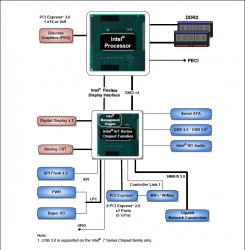What if you want to put 4 T-Bolt ports on a performance laptop (hypothetical question on this forum, since Apple doesn't make any performance laptops).
The chipset doesn't support 4 graphics devices, so what do you do about the graphics channel on the 3rd/4th T-Bolt connector?
That's the problem. If T-Bolt were PCIe extender only - no problem.
DisplayPort is not the problem in this situation. Two-port Thunderbolt devices already use DP 1:2 demuxes to feed their single available pixel pipeline to each of the Thunderbolt DP inputs. If you put two Thunderbolt controllers in a host device, you could easily feed all four DP inputs using two pixel pipelines and two DP 1:2 demuxes. Furthermore, systems with discrete GPUs are not necessarily limited to 3 pixel pipelines; there have been several demonstrations of 15-inch MBPRs driving 3 external displays plus the built-in panel. The number of displays you can drive will always be limited by the number of pixel pipelines the hardware supports, however it in no way limits the number of Thunderbolt ports you can have.
What does limit the number of Thunderbolt ports on a device is their power requirement. The upper bound on performance is really just TDP. Take Titan, for example: 17.59 petaFLOPS using just AMD Opterons and NVIDIA Teslas, but it consumes 8.2MW in the process. The volume of a device determines the acceptable range of TDP. From there, you can try to increase performance per watt as much as possible, or make trade-offs in terms of battery life or mass. Apple generally leads the industry by a healthy margin when it comes to meaningful performance per liter (the current Mac Pro situation notwithstanding). The 15-inch MBPs can be specced with up to a 3820QM, the fastest processor Intel makes under 50W, so I can't imagine it's CPU "performance" that you're complaining about. They also have more I/O bandwidth than any other notebook on the market by miles, so I guess it's just the NVIDIA GeForce GT 650M that doesn't meet with your satisfaction. Well, if you're looking for workstation class graphics or dual GTX 680Ms in SLI for gaming, then no, Apple doesn't go there. The largest notebook in Apple's lineup is also right around 2 liters and weighs in at 5.6 lbs., with the Retina version being only 1.5 liters and 4.46 lbs. If you'd care to show me some "performance" laptops that offer more performance per watt, more performance per liter, or offer even comparable performance, battery life and thermals in the same size package, I'd love to see them.
SUVs aren't higher performance cars, they're just bigger, uglier and less efficient/worse for the environment.
Thank you for emphasizing my point. There's no silicon for T-Bolt switches. You can only daisy-chain (throw up in my mouth a bit) a few nodes.
Here are your options:
1.) All Thunderbolt devices are port-blocking. This keeps the cost of devices to a minimum, but only allows for the connection of as many devices as the host has ports.
2.) Create a Thunderbolt controller with an embedded 2-port switch so that non-blocking devices can be made which allow for daisy chaining up to 6 devices off of a single host port. 2-port devices will retail for approximately $100 more than the equivalent port-blocking version.
3.) All Thunderbolt devices are port-blocking, however, you also produce and market a Thunderbolt switch that allows for tiered-star topologies. These would offer 5-8 ports and retail for about $550-$850. If a consumer does not buy a switch, they can only connect as many devices as their host has ports.
4.) Go with option #2, but also produce a switch once the market has gained sufficient maturity and the economics of doing so are justifiable.
You have chosen option #5, offer no practical solution due to a fear of daisy-chains resulting from some horrible experience at some point in your life.
The only devices which present additional complexity in a daisy chain vs. a tiered-star are storage devices, everything else can be hot-plugged just fine. Before being disconnected, external storage volumes directly connected to a host port still need to be properly unmounted, or, in the case of boot volumes, the system needs to be shut down. The same applies to all volumes connected via a hub or switch if you need to disconnect that hub or switch. The only time daisy chains become annoying is if you are forced to position boot volumes or volumes that cannot be conveniently unmounted towards the end of a chain, or a device in the chain loses power and disconnects all the devices further down the line. Obviously these situations are only partially mitigated in a tiered-star. Is there something I'm missing that triggers your Gordon Ramsay style reaction?



